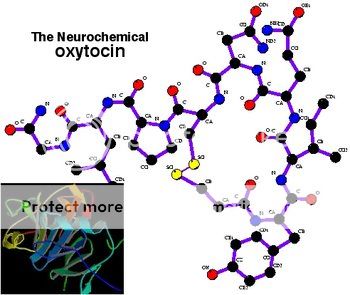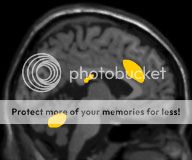
You spot someone across a crowded room. There is eye contact. Your heart beats a little faster, palms are sweaty, you’re light-headed, and your suddenly-squeamish stomach has dropped to your knees. You’re either suffering from an onset of food poisoning or you’re in love. But what does that mean, scientifically, to fall in love, to be in love, to stay in love? In our special Valentine’s Day post, Editor Jovana Grbić expounds on the neuronal and biophysical markers of love, how psychologists and mathematicians have harnessed (and sometimes manipulated) this information to foster 21st Century digital-style romance, and concludes with a personal reflection on what love really means in the face of all of this science. You might just be surprised. So, Cupid, draw back your sword… and click “continue reading” for more!
What is This Thing Called Love?
Scientists are naturally attracted to romance. Why do we love? Falling in love can be many things emotionally, ranging from the exhilarating to the truly frightening. It is, however, also remarkably methodical, with three stages developed by legendary biological anthropologist Helen Fisher of Rutgers University—lust, attraction and attachment—each with its own distinct neurochemistry. During lust, in both men and women, two basic sex hormones, testosterone and estrogen, primarily drive behavior and psychology. Interestingly enough, although lust has been memorialized by artists aplenty, this stage of love is remarkably analytical. Psychologists have shown that those individuals primed with thoughts of lust had the highest levels of analytical thinking, while those primed with thoughts of love had the highest levels of creativity and insight. But we’ll get to love in a minute.

During attraction, a crucial trio of neurotransmitters, adrenaline, dopamine and serotonin, literally change our brain chemistry, leading to the phase of being obsessed and love-struck. Remember how we talked about a racing heart and sweaty palms upon seeing someone you’re smitten with? That would be a rush of adrenaline (also referred to as epinephrine), the “fight or flight” hormone/neurotransmitter, responsible for increased heart rate, contraction of blood vessels, and dilation of air passages. Dopamine is an evolutionarily-conserved, ubiquitous neurotransmitter the regulates basic functions such as anatomy, movement and cognition—a reason the loss of dopamine in Parkinson’s Disease patients can be so devastating. Dopamine is also responsible for the pleasure and reward mechanisms in the brain, hyperactivated by abuse of drugs such as cocaine and heroin. It has even been linked to creativity and idea generation via interactions of the frontal and temporal lobes and the limbic system. This is, therefore, that link between love and creativity that we mentioned above. Incidentally, the releasing or induction agent of norepinephrine and dopamine is a chemical called phenethylamine (PEA). Did you give your sweetheart chocolates for Valentine’s Day? If so, you did well, because chocolate is loaded with some of the highest naturally-occurring levels of phenethylamine, leading to a “chocolate theory of love.” If you can’t stop thinking about your beloved, it’s because of serotonin, one of love’s most important chemicals. Its neuronal functions include regulation of mood, appetite, sleep, and cognitive functions—all affected by love. Most modern generation antidepressants involve alteration of serotonin levels in the brain.

During latent attachment, two important chemicals “seal the deal” for long-term commitment: oxytocin and vasopressin. Oxytocin, often referred to as “the hormone of love,” is a neurotransmitter released during childbirth, breastfeeding and orgasms, and is crucial for species bonding, trust, and unconditional love. A sequence of experiments showed that trust formation in group activities, social interaction, and even psychological betrayal hinged on oxytocin levels. Vasopressin is a hormone responsible for memory formation and aggressive behavior. Recent research also suggests a role for vasopressin in sexual activity and in pair-bond formation. When vasopressin receptor gene was transplanted into mice (natural loners), they exhibited gregarious, social behaviors. That gene, the vasopressin receptor, was isolated in the prarie vole, among the select few of habitually monogamous mammals. When the receptor was introduced into their highly promiscuous Don Juan meadow vole relatives, they reformed their wicked rodent ways, fixated on one partner, guarded her jealously, and helped rear their young.
With all these chemicals floating around in the brain of the aroused and the amorous, it’s not surprising that scientists have deduced that the same brain chemistry responsible for addiction is also responsible for love!
The aforementioned Dr. Fisher gave an exceptional TED Talk in 2006 about her research in romantic love; its evolution, its biochemistry, and its social importance:

While the heart may hold the key to love, the brain helps unlock it. In fact, modern neuroscience and magnetic resonance imaging (MRI) scanning has helped answer a lot of questions about lasting romances, what being in love looks like, and whether there is a neurological difference between how we feel about casual sex, platonic friends, and those we’re in love with. In a critical fMRI study the brains of people who were newly in love were scanned while they looked at photographs, some of their friends and some of their lovers. Pictures of lovers activated specific areas of the brain (pictured on the left) that were not active when looking at pictures of good friends or thinking about sexual arousal, suggesting that romantic love and mate attachment aren’t so much of an emotion or state of mind as they are a deeply rooted drive akin to hunger, thirst and sex. Furthermore, a 2009 Florida State study showed that people in a committed relationship and are thinking of their partner subconsciously avert their eyes from an attractive member of the opposite sex. The most heartwarming part of all? It lasts. fMRI imaging of 10 women and 7 men still claiming to be madly in love with their partners after an average of 21 years of marriage showed equal brain activation to the earlier studies of nascent romances.
In case you’re blinded by all this science, remember this central fact about love: it’s good for you! The art of kissing has been shown to promote many health benefits, including stress relief, prevention of tooth and gum decay, a muscle workout, anti-aging effects, and therapeutic healing. If everything goes well with the kissing, it could lead to an even more healthy activity… sex! Not only does sex improve your sense of smell, boost fitness and weight loss, mitigate depression and pain, but it also strengthens the immune system, prevents heart disease and prostate cancer. In fact, “I have a headache” may be a specious excuse to avoid a little lovin’ since sex has been shown to cure migraines (and cause them, so be careful!). All of these facts and more, along with everything you ever wanted to know about sex, were collected and studied by neuroscientist Barry Komisaruk, endocrinologist Carlos Beyer-Flores and sexuality researcher Beverly Whipple in The Science of Orgasm. Add it to your shopping list today! The above activities may find you marching down the aisle, which especially for men is a very, very good thing. Studies show that married men not only live longer and healthier lives but also made more money and were more successful professionally (terrific New York Times article here).
Love in the Age of Algebra
While science can pinpoint the biological markers of love, can it act as a prognosticator of who will get together, and more importantly, stay together? Mathematicians and statisticians are sure trying! One of the foremost world-renowned experts on relationship and marriage modeling is University of Washington psychology professor John Gottman, head of The Gottman Institute and author of Why Marriages Succeed or Fail. Dr. Gottman uses complex mathematical modeling and microexpression analysis to predict with 90% accuracy which newlyweds will remain married four to six years later, and with 83% accuracy seven to nine years thereafter. In this terrific profile of Gottman’s “love lab,” we see that his methodology includes use of a facial action coding system (FACS) to analyze videotapes for minute signs of negative expressions such as contempt or disgust during simple conversations or stories. Take a look at this brief, fascinating video of how it all works:
Naturally, the next evolutionary step has been to cash in on this science in the online dating game, where successful matchmaking hinges on predicting which couples will be ideally suited to each other on paper. Dr. Helen Fisher has used her expertise in the chemicals of love to match couples through their brain chemistry personality profiles on Chemistry.com. eHarmony has an in-house research psychologist, Gian Gonzaga, an ardent proponent of personality assessment and skeptic of opposites attracting. Finally, the increasingly popular Match.com boasts of a radically advanced new personality profile called “match insights,” devised by none other than Dr. Fisher and medical doctor Jason Stockwood. If you don’t believe in the power of the soft sciences, you can take your matchmaking to a molecular level, with several new companies claiming to connect couples based on DNA fingerprints and the biological instinct to breed with people whose immune system differs significantly from ours for genetic stability. ScientificMatch.com promises that its pricey, patent-pending technology “uses your DNA to find others with a natural odor you’ll love, with whom you’d have healthier children, a more satisfying sex life and more,” while GenePartner.com tests couples based on only one group of genes: human leukocyte antigens (HLAs), which play an essential role in immune function. The accuracy of all of these sites? Mixed. Despite the problem of rampant lying in internet dating profiles and dating in volume to pinpoint the right match, some research has shown remarkably high success (as high as 94%) in e-partners that had met in person.

What’s Science Got To Do With It?
In the shadow of such vast technological advancement and deduction of romance to the binary and biological, readers of this blog might imagine that its scientist editor might condemn decidedly empirical views of love. They would be wrong. For while numbers and test tubes and brain scanning machines can help us describe love’s physiological and psychological nimbus, its esoteric nucleus will forever be elusive. And thank heavens for that! There exists no mathematical formula (other than perhaps chaos theory) that can explain the idea of two people, diametrical as day and night, falling in love and somehow making it work. No MRI is equipped with a magnet strong enough to properly quantify the utter heartbreak of those that don’t. There is not a statistical deviation alive that could categorize my grandparents’ unlikely 55-year marriage, a marriage that survived World War II, Communism, a miscarriage, the death of a child, poverty, imprisonment in a political gulag, and yes, even a torrid affair. After my grandfather died, my grandmother eked out another feeble few years before succumbing to what else but a broken heart. It is within that enigma that generations of poets, scribes, musicians, screenwriters, and artists dating all the way back to humanity’s cultural dawning—the Stone Age—have never exhausted of material, and they never will.
Love exists outside of all the things that science is—the ordered, the examined, the sterile, the safe, and the rational. It is inherently irrational, messy, disordered and frustrating. Science and technology forever aim to eliminate mistakes, imperfection and any obstacles to precision, which in matters of the heart would be a downright shame. Love is not about impersonal personality surveys, neurotransmitter cascades or the incessant beeping of laboratory machines measuring its output. It’s about magic, mystery, voodoo and charm. It’s about experimenting, floating off the ground, being scared out of your mind, laughing uncontrollably and inexplicably, flowers, bad dates, good dates, tubs of ice cream and chocolate with your closest friends, picking yourself up and starting the whole process all over again. It’s not about guarantees or prognostications, not even by smart University of Washington psychologists. It’s about having no clue what you’re doing, figuring it out as you go along, deviating from formulas, books, and everything scientists have ever told you, taking a chance on the stranger across a crowded room, and the moon hitting your eye like a big-a pizza pie.
Now that’s amore!
Hope everyone had a great Valentine’s Day.
~*ScriptPhD*~
*****************
ScriptPhD.com covers science and technology in entertainment, media and advertising. Hire our consulting company for creative content development.
Follow us on Twitter and our Facebook fan page. Subscribe to free email notifications of new posts on our home page.
]]>